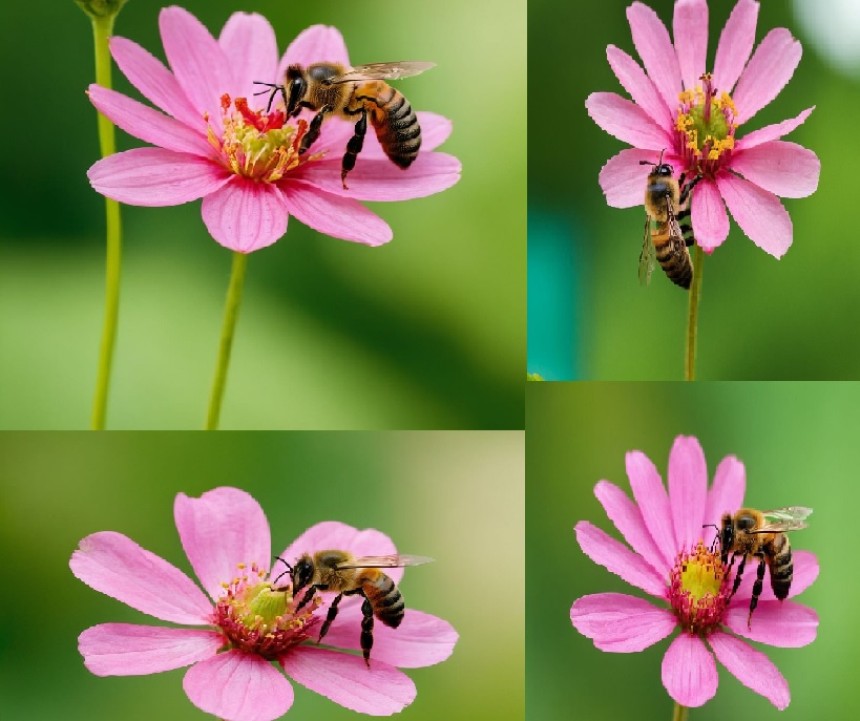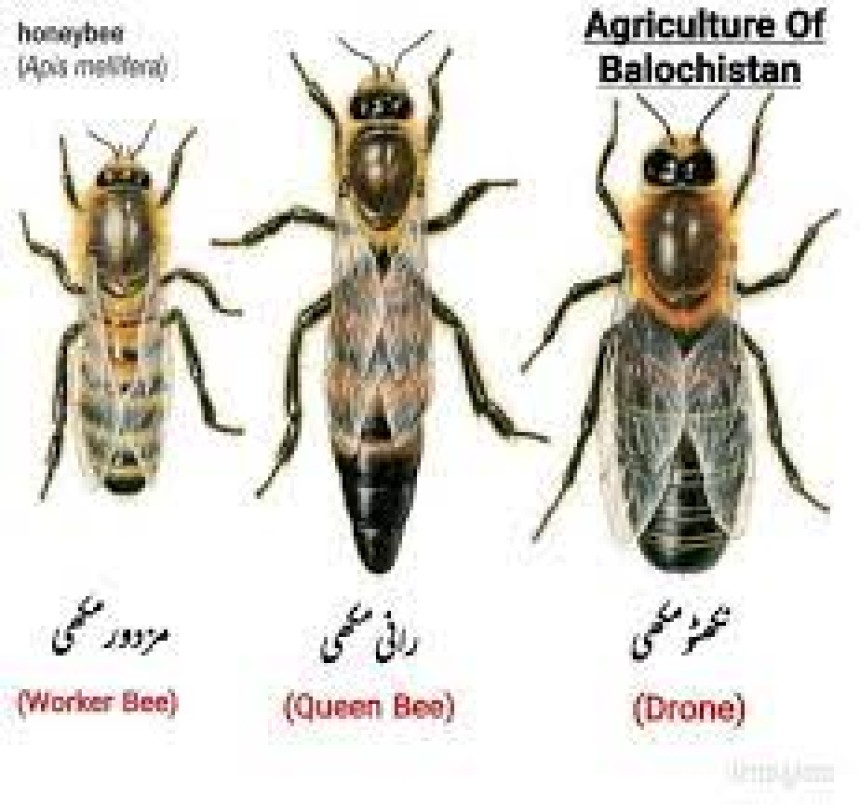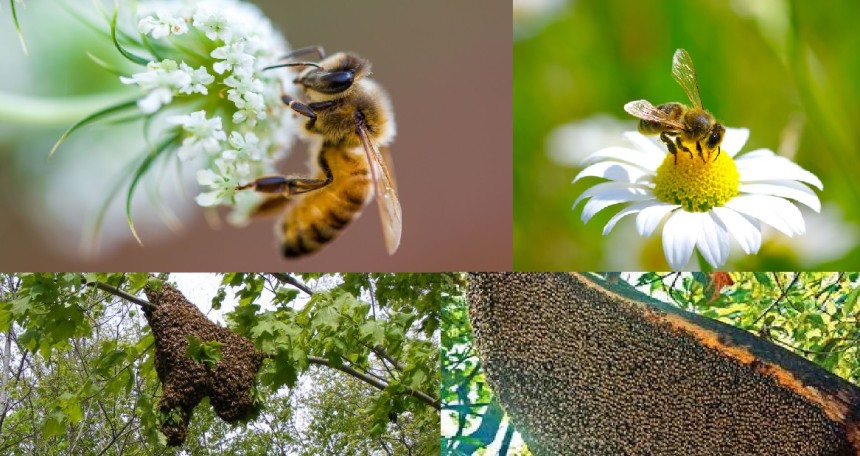
Learning from the Story of Honey Bees: عالمِ حشرات مگس کی کہانی سے سبق
We, the Humans live alongside various other living things on this planet Earth. Honey bees are so important to the environment and the world that we live in. Honey bees pollinate our plants and help us by increasing productivity in addition of providing Honey, which makes an important element in our food chain. This write up is about the lessons we may draw from the the world of Insect especially honey bees.
Learning from the Story of Honey Bees
ALLAH (swt) has created Humans as the Best of the creatures (Ashraf al-Makhluqat) in the world and created innumerable other creatures for his help and ease. Among them, insects are the largest group of invertebrates on Earth, and millions of species have been discovered so far. Some of them are crawling insects while some have the ability to fly. They usually have six or more than six legs.
Honey bee plays a very beneficial role for mankind. It not only provides honey, but also the role of bees in the field of agriculture is remarkable. It also plays an important role in the production of honey as well as in the pollination for various crops, fruits and vegetables, especially oilseeds and fodder.
The honey bee goes to the garden and sucks the juice from the flowers. Some of the sap turns into wax, which makes the honeycomb, and some of the sap turns into honey. When the hive is broken, the honey is separated from the wax.
Allah Ta'ala has invited us to think about the universe many times in the Holy Qur'an to prove His monotheism. Everything in the world, from the particle to the throne, from the angles to the human and from the mosquito to the elephant, the existence of everything is the masterpiece of creation of Allah Almighty and the eternal book of knowledge.
In the Holy Qur'an, "How many such creatures are there in the heavens and the earth, from whom these people turn their backs?" (Surah Yusuf, 105).
In Surah Nahl, Allah Ta'ala has made a meaningful reference to the signs of knowledge and thought in the life of a bee. The study of the life of honey bees, their collective lifestyle and their industrialization forces the human mind to think where did this creature get its ideal discipline and skill? Under whose direction are these manifestations taking place?
The life of honey bees is very organized. All bees have a chief bee, which is called Queen Bee. It neatly divides the responsibilities among all the bees. Some bees are responsible for the construction of the city, some for population growth, some for food supply and some for the protection of the city. Everyone performs their duty with dedication and honesty.
A bee sits on an average of two and a half hundred flowers in an hour, covering several kilometers. A bee that sucks sap from a smelly or dirty plant is killed at the entrance of the city. In bee society, laziness, uselessness and littering are punishable by death.
When a bee stings a body, the sting remains inside, the bee flies away but dies later. It is as if the bee's sting is a kind of suicide, because it loses its protective weapon. According to the inexorable law of nature, nations that cannot protect themselves are destroyed.
Modern research has revealed the wonders of bee communication that amaze us. More than 50 years ago, Carl von Frisch was awarded the Nobel Prize for recognizing the unique form of honey bee communication, the wiggle dance. [The waggle dance is a term used in beekeeping and ethics for the typical figure eight dance of the bee.] This dance was used by bees to communicate the location of food sources. Today, new discoveries continue to emerge, some from Dr. Martin Bencic's ongoing research into how bees use their sensitivity to vibrations to communicate through sound.
The old Honey Bee prefers an honorable death; How?
Have you ever seen the bees sitting on flowers in the evening; they are old bees.
Old and sick bees do not return to the hive at the end of their day. They spend the night on the flowers, and if they get a chance to see another sunrise, they resume their activities by bringing pollen or nectar to the colony. They do it realizing that the end is near. No bee waits to die in the hive so as not to burden others.
So, the next time you see an old bee sitting on a flower as the night ends, be sure to thank the bee for its lifetime of service that was spent squeezing the honey for us.


عالمِ حشرات مگس کی کہانی سے سبق
اللہ سبحان تعالی نے اشرف المخلوقات کو دنیا میں بسایا اور اس کی مدد اور آسانی کے لیے بےشمار دوسرے مخلوقات کو پیدا کیا۔ ان میں سے عالم حشرات یا کیڑے مکوڑے زمین پر پائے جانے والے غیرفقاری جانوروں کا سب سے بڑا گروہ ہے، اور اب تک ان کی لاکھوں اقسام دریافت کی جاچکی ہیں۔ ان میں سے کچھ رینگنے والے کیڑے ہوتے ہیں جبکہ کچھ اُڑنے کی صلاحیت بھی رکھتے ہیں۔ عموماً ان کی چھ یا چھ سے زائد ٹانگیں ہوتی ہیں۔
مگس یعنی شہد کی مکھی بنی نوع انسان کے لیے انتہائی فائدہ مند کردار ادا کرتی ہے۔ یہ نہ صرف شہد مہیا کرتی ہے بلکہ زراعت کے شعبہ میں بھی شہد کی مکھیوں کا کردار قابل ذکر ہے۔ یہ شہد تیار کرنے کے ساتھ ساتھ مختلف فصلوں، پھلوں اور سبزیوں خصوصاً تیلدار اجناس اور چارہ جات کے عملی زیرگی میں بھی اہم کردار ادا کرتی ہے۔
’’ مگس شہد کی مکھی باغ میں جا کے پھولوں سے رس چوستی ہے۔ کچھ رس موم میں بدل جاتا ہے جس سے چھتہ بنایا جاتا ہے اور کچھ رس شہد میں بدل جاتا ہے۔جب چھتہ توڑا جاتا ہے تو شہد کو موم سے الگ کرلیا جاتا ہے۔
ﷲ تعالیٰ نے اپنی توحید کے ثبوت کے لیے قرآن ِپاک میں بارہا کائنات پرغوروفکرکی دعوت دی ہے۔ دُنیا میں موجود ہرشئے، ذرّے سے عرش تک، ملک سے بشرتک اور مچھر سے ہاتھی تک، ہرشئے کا وجود اﷲ تعالیٰ کی تخلیق کا شاہ کاراورمعرفت کی لازوال کتاب ہے۔
قرآن مجید میں ہے ’’ارض وسما میں کتنی ہی ایسی مخلوقات ہیں جن سے یہ لوگ منہ پھیرکرگزرجاتے ہیں۔‘‘(سورۂ یوسف،105)
سُورۂ نحل میں اﷲ تعالیٰ نے انسان کے لیے شہدکی مکھی کی زندگی میں جو معارف وفکرکی نشانیاں ہیں، اُن کی طرف ایک معنی خیزاشارہ کیاہے۔ شہدکی مکھیوں کی زندگی، ان کا اجتماعی طرزِحیات اوراُن کی صنعت کاری کامطالعہ انسانی عقل کوسوچنے پرمجبورکردیتا ہے کہ اس مخلوق نے مثالی نظم وضبط اور ہنرمندی کہاں سے حاصل کی ؟ کس کی ہدایت پریہ مظاہروقوع پزیرہوتے ہیں؟
شہدکی مکھیوں کی زندگی بہت منظم ہوتی ہے ۔تمام مکھیوں کی ایک سردارمکھی ہوتی ہے، جسے امیرالنحل کہتے ہیں ۔یہ سلیقے سے تمام مکھیوں میں ذمّے داریاں بانٹتی ہے۔ کچھ مکھیوں پر شہرکی تعمیر،کچھ پرافزائش ِآبادی، کچھ پرغذاکی فراہمی اورکچھ پرشہرکی حفاظت کی ذمّے داری ہوتی ہے۔ ہرمکھی پوری تن دہی اورایمان داری سے اپنافریضہ اداکرتی ہے۔
شہد کی مکھی ایک گھنٹے میں اوسطاً اڑھائی سو پھولوں پربیٹھتی ہے ،کئی کلومیٹرکاسفرطے کرتی ہے ۔
بدبودار یا گندے نباتات سے رَس چوس کرچھتّے میں لانے والی مکھی کوشہرکے دروازے پرہی ماردیاجاتاہے۔
شہد کی مکھیوں کے معاشرے میں سُستی، کاہلی کا مظاہرہ کرنے اور گندگی پھیلانے کی سزا موت ہے۔
شہدکی مکھی جب کسی جسم پرڈنک چبھوتی ہے تو ڈنک اندرہی رہ جاتاہے، مکھی اس وقت تو اُڑجاتی ہے لیکن بعدمیں مرجاتی ہے ۔گویااس کاڈنک مارناایک طرح سے اس کی خودکشی ہے، کیوں کہ وہ اپنے حفاظتی ہتھیار سے محروم ہوجاتی ہے۔ قدرت کے اس اٹل آئین کے مطابق کہ جواقوام اپنی حفاظت خودنہیں کرسکتیں، وہ مِٹادی جاتی ہیں۔
جدید تحقیق نے شہد کی مکھیوں کے رابطے کے عجائبات بیان ہوئے ہیں جو ہمیں ششدر کردیتے ہیں۔ کئی 50 سال پہلے کارل وون فریش کو شہد کی مکھی کی مواصلات کی منفرد شکل ویگل ڈانس کو تسلیم کرنے پر نوبل انعام سے نوازا گیا تھا۔ [واگل ڈانس ایک اصطلاح ہے جو شہد کی مکھیوں کی مکھیوں کے پالنے اور اخلاقیات میں شہد کی مکھی کے مخصوص اعداد و شمار آٹھ رقص کے لیے استعمال ہوتی ہے۔]
اس رقص کو شہد کی مکھیاں کھانے کے ذرائع کے مقام کو بتانے کے لیے استعمال کرتی تھیں۔ آج، نئی دریافتیں مسلسل سامنے آ رہی ہیں، کچھ ڈاکٹر مارٹن بینسک کی جاری تحقیق سے کہ شہد کی مکھیاں آواز کے ذریعے بات چیت کرنے کے لیے کمپن کے لیے اپنی حساسیت کو کس طرح استعمال کرتی ہیں۔

بوڑھی مگس باعزت موت کو ترجیح دیتی ہے؛ کیسے؟
کیا آپ نے کبھی دیکھا ہے؟ وہ شہد کی مکھیاں جو آپ شام کو پھولوں پر بیٹھی دیکھتے ہیں وہ بوڑھی مکھیاں ہیں۔
بوڑھی اور بیمار شہد کی مکھیاں اپنے دن کے اختتام پر چھتے میں واپس نہیں آتیں۔ وہ رات پھولوں پر گزارتی ہیں، اور اگر انہیں ایک اور طلوع آفتاب دیکھنے کا موقع ملتا ہے، تو وہ کالونی میں جرگ یا امرت لا کر اپنی سرگرمیاں دوبارہ شروع کر دیتے ہیں۔ وہ یہ احساس کرتے ہوئے کرتے ہیں کہ انجام قریب ہے۔ کوئی بھی مکھی چھتے میں مرنے کا انتظار نہیں کرتی تاکہ دوسروں پر بوجھ نہ پڑے۔
لہذا، اگلی بار جب آپ دیکھیں گے کہ ایک بوڑھی شہد کی مکھی ایک پھول پر بیٹھی ہے جیسے ہی رات ختم ہوتی ہے تو اس شہد کی مکھی کی زندگی بھر کی خدمت کے لیے شکریہ ضرور ادا کیجیے گا جس نے ہماے لیے شہد نچوڑا تھا۔
Microbiology Testing Market Expansion Strategies for 2031 Success
Microbiology Testing Market Size: The Microbiology Testing Market is projected to grow fr...




